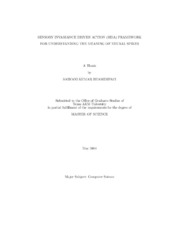| dc.contributor.advisor | Choe, Yoonsuck | |
| dc.creator | Bhamidipati, Sarvani Kumar | |
| dc.date.accessioned | 2004-09-30T02:08:25Z | |
| dc.date.available | 2004-09-30T02:08:25Z | |
| dc.date.created | 2005-05 | |
| dc.date.issued | 2004-09-30 | |
| dc.identifier.uri | https://hdl.handle.net/1969.1/529 | |
| dc.description.abstract | What does the spike of a sensory neuron mean? This is a fundamental question in computational neuroscience. Conventional approaches provide an answer based on correlation between spike pattern and the stimulus that caused it. However, these approaches do not satisfactorily explain how the brain, which does not have direct knowledge of the world or the stimuli, can achieve this task. This thesis frames the problem in terms of a task for a simulated agent and provides a solution based on an approach which regards action as necessary for acquiring the meaning of neural spikes. This approach differs from some others in that it proposes a new criterion called the sensory invariance criterion, which can be used to associate meaning to spike patterns in terms of action sequences the agent generates. This criterion forms the basis of the Sensory Invariance Driven Action (SIDA) framework presented in this thesis. This framework is implemented in a reinforcement learning agent and the results indicate that the agent can successfully learn to associate meaning to the sensor activity in terms of specific actions which reflect the properties of the stimulus. Further behavioral experiments on the agent show that this framework allows the agent to learn the meaning of complex (spatiotemporal) spike patterns. The successful learning exhibited by the agent raises hopes that SIDA can be used to build agents with natural semantics. | en |
| dc.format.extent | 781988 bytes | en |
| dc.format.extent | 108299 bytes | en |
| dc.format.medium | electronic | en |
| dc.format.mimetype | application/pdf | |
| dc.format.mimetype | text/plain | |
| dc.language.iso | en_US | |
| dc.publisher | Texas A&M University | |
| dc.subject | Sensory Invariance | en |
| dc.subject | Sensorimotor Approach | en |
| dc.subject | Agent | en |
| dc.subject | SIDA | en |
| dc.title | Sensory invariance driven action (SIDA) framework for understanding the meaning of neural spikes | en |
| dc.type | Book | en |
| dc.type | Thesis | en |
| thesis.degree.department | Computer Science | en |
| thesis.degree.discipline | Computer Science | en |
| thesis.degree.grantor | Texas A&M University | en |
| thesis.degree.name | Master of Science | en |
| thesis.degree.level | Masters | en |
| dc.contributor.committeeMember | Friesen, Donald K. | |
| dc.contributor.committeeMember | Langari, Reza | |
| dc.type.genre | Electronic Thesis | en |
| dc.type.material | text | en |
| dc.format.digitalOrigin | born digital | en |


